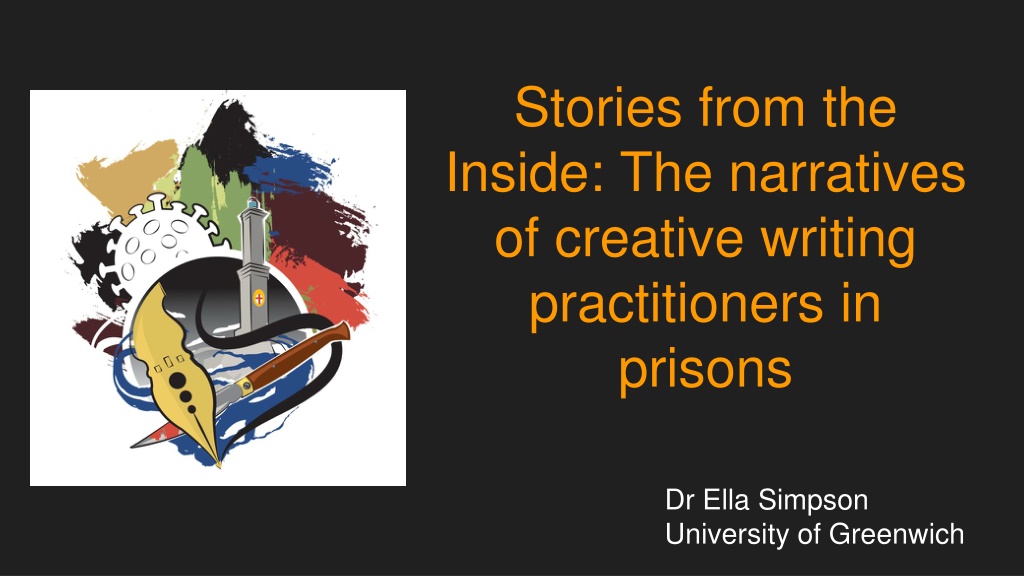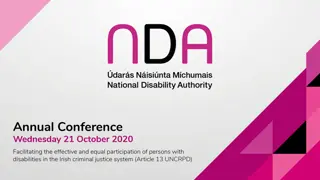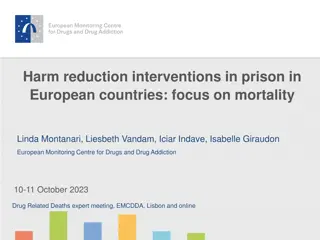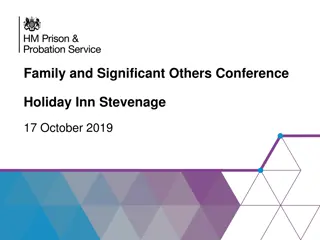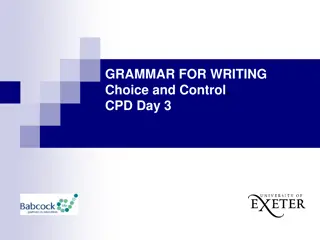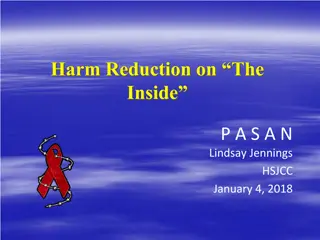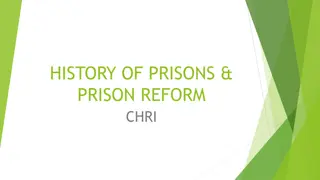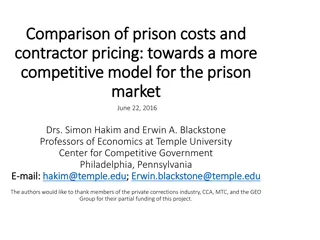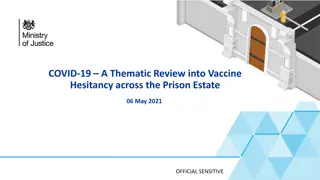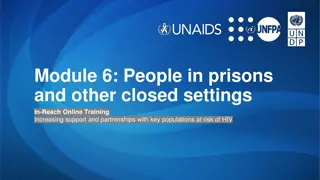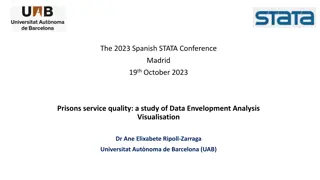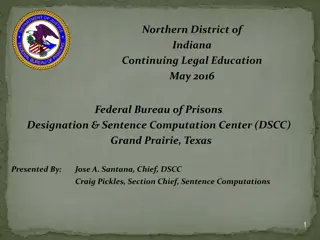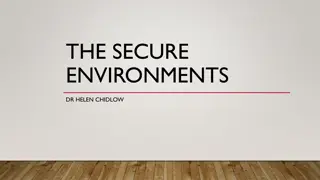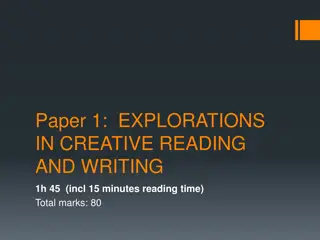Exploring Creative Writing Practitioners' Impact in Prisons
Delve into the realm of creative writing practitioners in prisons as they narrate stories of transformation, emphasizing the power of the arts in fostering positive change. Uncover the relational dynamics and captivating anecdotes that shed light on the practitioners' meaningful interactions with inmates. Unveil the unexplored territories of practitioner narratives and their profound influence within prison settings.
- Creative Writing
- Arts Interventions
- Prison Rehabilitation
- Practitioner Narratives
- Transformational Relationships
Download Presentation

Please find below an Image/Link to download the presentation.
The content on the website is provided AS IS for your information and personal use only. It may not be sold, licensed, or shared on other websites without obtaining consent from the author. Download presentation by click this link. If you encounter any issues during the download, it is possible that the publisher has removed the file from their server.
E N D
Presentation Transcript
Stories from the Inside: The narratives of creative writing practitioners in prisons Dr Ella Simpson University of Greenwich
Desistance and the Arts Narrative of transformation constructs the arts as able to change lives for the better (Belfiore and Bennett, 2008) Most recent review by Cheliotis (2014) = Arts can contribute to desistance through: psychological and attitudinal changes learning capacity and motivation building social skills Research increasingly neglects the voice of the practitioner, see especially Intermediate Outcomes Measurement Instrument (Maguire et al. 2019: 21)
Relational Dimensions of Arts Interventions Relationships between prisoners (e.g. Anderson et al, 2011; Caulfield, 2015; De Viggiani et al., 2010) Prisoner/staff relationships (e.g. McKean, 2006; Nugent and Loucks, 2011; Wilson et al., 2008) Prisoner and family relationships (e.g. Kinsella and Woodall, 2016; Cox and Gelsthorpe, 2008; Boswell et al., 2011) Relationships between prisoners and practitioners (e.g. Bilby, Caulfield and Ridley. 2013; Cursley and Maruna, 2015; Albertson, 2015; Tomczak and Albertson, 2016)
Practitioner/Prisoner Relationship Cursley and Maruna (2015) find success of long term music project is due to relationships participants form with practitioners Practitioners act as role models ((Van Maanen, 2010; Chelitos, 2014) Practitioners are seen as change agents providing a catalyst for change through meaningful and empowering relationships (O Keefe and Albertson, 2012: 69) Practitioners are valued for their professional status and ability to set boundaries (Bilby et al, 2013)
The real stories of practitioners There is little research that describes what arts practitioners actually do in sessions and, more importantly, how they go about doing it. (Anderson, 2015: 372) Small amount of anecdotal literature (Smith, 1989; Hopwood, 1999; Hadaway, Ward and Menhennet,1993; Flusfeder, 2004; Wade, 2008; Bidder, 2016; Thorn, 2012; Bridgeman, 2013; Gavron, 1996; WIPN, 2020a; Fulleylove, 1998) My research combines autobiographical narratives of practitioners with a robust narratological analysis
Research Questions How do creative writing practitioners construct their intentions, motivations and journeys into prison through the stories they craft? What can these narratives tell us about the work that practitioners do with prisoners?
Methodology Taking story seriously on its own narrative terms Moving away from oral narratives to deliberately crafted written stories Less researcher interpretation more authentic practitioner voice a constitutive view of narrative (Presser, 2009: 184)
Data Collection Method: Eight-Frame Storyboard 19 creative writing practitioners with at least one year s experience in prison Participation in one of two creative writing workshops (9 or 10 members in each group)
Methods of Analysis Narratology (Bal, 2009) Identify the fabula - the bare bones of the narrative Actantial Analysis (Greimas, 1966; Herbert, 2011) Identify key narrative functions - including motivation and goal
6 Types of Alterity Type of alterity Art Itself Anti- authority/ Protest Reject status quo Early institutional experience Identify with/ help the other Mental health Number of participants 8 5 4 3 5 6
Actantial Analysis (Greimas, 1966) The actantial model enables an action, defined as a syntagmatic organisation of acts (Greimas and Courtes, 1984, p. 6)...to be broken up into six structural components, or actantial classes. (Simpson, 2022: 86)
Practitioners Ambitions Ambition/Motivation No. of Practitioners Professional Creative Ambitions 3 Abstract Desire to Engage with Process and Practice of the Creative Arts 7 Non-Creative Professional Ambitions 2 Personal or Existential Aspirations 6 Not Amenable to Actantial Analysis 1 Total 19
Three Types of Narrative Individual Narrative Cultural Narrative (Belfiore and Bennett, 2008) The Suffering Artist The Arts as in Crisis and Beleaguerment The (Inadvertent) Healer The Arts as Therapeutic The (Human) Revolutionary The Arts as Transformative
Practitioners Significant Stories Practitioners are rarely interested in rehabilitating prisoners (n.16) Most practitioners don t want to be in prison (n.15) Majority of practitioners (n.11) have a desire to escape Over half of practitioners (n.9) resist authority Almost all practitioners (n.16) have a sense of an outsider status
Shared Stories of Outsiders Creative practitioners (musicians) and offender (drug users) share the experience of being labelled as outsiders (Becker, 1963) Becker (1963) notes creative practitioners unwillingness to made force normal social conventions on others - which aligns with desistance principle of non-judgemental support in work with offenders (McNeill et al., 2012: p.4) Research increasingly neglects the voice of the practitioner, see especially Intermediate Outcomes Measurement Instrument (Maguire et al. 2019: 21)
Future Stories Need for authentic stories of practitioners to be included in research on the creative arts in prisons Research to include prisoners authentic stories to better understand relationship dynamics Use of creative data collection methods to elicit these stories
